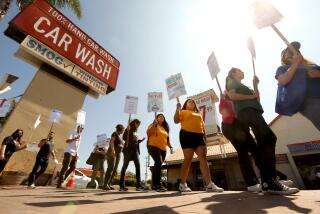Seeking Solutions for the Many Problems of ’91
- Share via
The year started with a war and ended with a record number of homicides and the loss of about $300 million to build jails and courts. In between, the public agenda was full of drought, recession and budget deficits. What progress was made on some of San Diego’s most pressing public policy issues, and what needs to be done in 1992?
CRIME AND THE JUSTICE SYSTEM
* The new sheriff, Jim Roache, was much more open and willing to work with other county officials than his predecessor.
* A 1,500-bed jail was completed at East Mesa. Only a small part of it is open, because the county lacks funds to operate it. But, through a creative plan of leasing space in some jails to the federal government and transferring inmates and staff to the more efficient East Mesa jail, the county expects to open the rest of the facility by March. Optimistically, Roache says, this could add 500 beds to the severely crowded jail system.
* The city of San Diego found the money to build a 200-bed pretrial detention facility, also on East Mesa. It should be completed in April.
* The backlog of pending criminal cases dropped from 3,000 to 1,400. San Diego Superior Court Judge Jesus Rodriguez, who spearheaded the drop, draws compliments from both prosecutors and defense attorneys for his management of the criminal courts. In addition to setting a firm 50-day trial start, which speeds plea bargaining, Rodriguez also stopped the practice of “judge-shopping.” Repeat offenders also are getting quicker justice. Instead of trying such defendants on the new charges, the district attorney seeks to have probation revoked.
Rodriguez switched jobs in September, and pending cases were back up by year’s end to 1,700--but, other judges said, that rise seems like a temporary blip since the Rodriguez system is still in place.
* Community groups and neighborhood residents got more involved in fighting crime. Also, the city’s first roving community patrols were organized in the Hillcrest-North Park areas following a string of robberies and assaults.
* A record number of homicides were committed in both the city of San Diego and countywide. There were 179 homicides in the city and 301 countywide. Violent crime in general went up more than 16%. The victims included several innocent youths.
* San Diego Police Chief Bob Burgreen plans to put additional officers, transferred from administrative and detective positions, back on the streets. But police officials say that 25% to 30% of the time the number of patrol officers falls below the minimum staffing the department recommends for public safety. The city still has only 1.6 officers per thousand, too few for a city of 1.1 million.
* The state Supreme Court overturned a half-cent sales tax for jails and courts, saying that it violated the Proposition 13 requirement of a two-thirds vote for special taxes. The 1988 measure was passed by just a bare majority of the electorate.
The county Board of Supervisors’ attempt at an end run around the anti-democratic two-thirds majority rule was poorly executed. Worse, the board was ill-prepared for an adverse ruling. Finding a new way to fund courts and jails must be at or near the top of the board’s agenda for 1992. Another tax measure will be difficult in these tough economic times, but the county has little option. Any new tax measure should also include some money for anti-drug education, drug treatment and other crime prevention programs and for police.
* The need for improved psychological screening of police officers and deputies was made obvious after a deputy was killed while committing a robbery, another deputy pleaded guilty to sexual battery while on duty, and another was charged with rape.
Adding to questions about police screening were the 35 charges filed against San Diego Police Officer Henry Hubbard Jr., including rape and robbery.
* Two of eight positions on the federal district court in San Diego remain vacant, at a time when the criminal caseload per judge is the highest in the country.
DROUGHT
1991 was the fifth consecutive year of drought for San Diego and the state. And a sixth year is looking increasingly possible.
* San Diegans became much more water-conscious. They were forced to, when the Southern California-wide Metropolitan Water District cut water deliveries last spring. For a while, 50% cutbacks were threatened. The “miracle March” rains and snow made only 31% cutbacks necessary.
San Diego city residents voluntarily used 16% less water in the last half of 1991, contrasted with the same period in 1990. County Water Authority figures show 25% less water delivered to its customers in 1991 over 1990.
* But ,when the crisis eased, so did the conservation resolve. In August, water users were saving 32.3%. Just three months later, that figure was down to 14.6%. And local leadership on the issue weakened.
* The County Water Authority scaled back its conservation goal in April from 31% to 20%, making up the difference by buying more expensive water from the state and dipping into emergency reserves.
* The city of San Diego backed off of its tiered water-rate structure designed to reward conservation.
* There was talk of scaling back the water reclamation system planned for the city of San Diego because of cost. This would be a serious mistake in an area that must import 95% of its water, making it unusually vulnerable to drought, disaster and the politics of water distribution.
PUBLIC SERVICES
* San Diego County, which has received less than its share of state health and mental health funds for more than a decade, could receive up to $45 million in extra funds over the next five years. However, little benefit is expected in the short run, because of an increased demand for services and reduced tax revenues caused by the recession. But the new formula should be helpful down the road.
* New Beginnings, a program designed to coordinate social services, got its start in 1991. It should save time and paperwork and increase the effectiveness of the services.
* After cutting tens of millions of dollars from its budget this year, the county still faces about a $15-million deficit in the current fiscal year. The county employees’ union deserves credit for agreeing to a program of voluntary furloughs. And employees would be wise to take the time off and absorb the pay loss. It could save many of their jobs.
* The Board of Supervisors has scaled back the general relief welfare program. Recipients who are deemed “employable” will be able to receive benefits for just three months. Politically ambitious Supervisor Susan Golding seized on a popular issue. But the approach is fraught with problems.
First of all, the move is probably illegal and will likely be challenged in court. Second, jobs are scarce, so welfare recipients could be forced onto the street. The welfare program needs reform, but this is not the way to go about it. Make the cuts elsewhere.
* The city of Oceanside’s budget was also hit hard, in part because of the loss of the Marines during Desert Storm and the tax dollars they spent in the city. A $4-million deficit forced cuts in police and firefighting services last year.
HEALTH
* San Diego General Hospital closed after years of severe financial problems. This shifted the burden of many uninsured poor people onto other hospitals.
* County budget cuts forced the closing of the Vista health center.
* Increasing unemployment and the numbers of people without medical insurance is sure to add to the strain of hospitals countywide.
EDUCATION
* The 2 1/2-year struggle to establish a health center at San Diego’s Hoover High School ended when the school board gave its blessing to the clinic, which would offer primary health care as well as a variety of social services. The first of its kind in the county, the clinic is intended to address a situation where more than 40% of Hoover High students are not covered by any medical insurance, and more than a third of the students use the school nurse as their primary source of medical care.
* SDSU’s younger sister, Cal State San Marcos, went relatively unscathed by the budget ax and maintained a growth pattern in its second year of classes, tripling its enrollment and adding more faculty and courses.
* Elementary and high schools managed to avoid major teacher layoffs this academic year, despite dire budget predictions made in the spring.
However, educators made deep cuts in administrative and maintenance areas that they fear could come back to haunt them in 1992.
* State budget cutbacks resulted in the cancellation of more than 660 classes at San Diego State University and the layoffs of most part-time faculty members.
* Test scores in the San Diego Unified School District showed a widening gap in achievements between white and Asian students, and other minorities, especially blacks. This issue is likely to be hotly debated in 1992.
HOUSING
* The city of San Diego lost an excellent opportunity to save 816 units of low-income housing. The owner of the apartments, Alvin Malnik, backed out of the deal after months of hassle in trying to consummate it.
Mayor Maureen O’Connor contended that the purchase was a bad deal for the city and waged a campaign to halt it. Unfortunately, she succeeded. And these apartments could eventually be converted to market-rate units.
More to Read
Sign up for Essential California
The most important California stories and recommendations in your inbox every morning.
You may occasionally receive promotional content from the Los Angeles Times.













